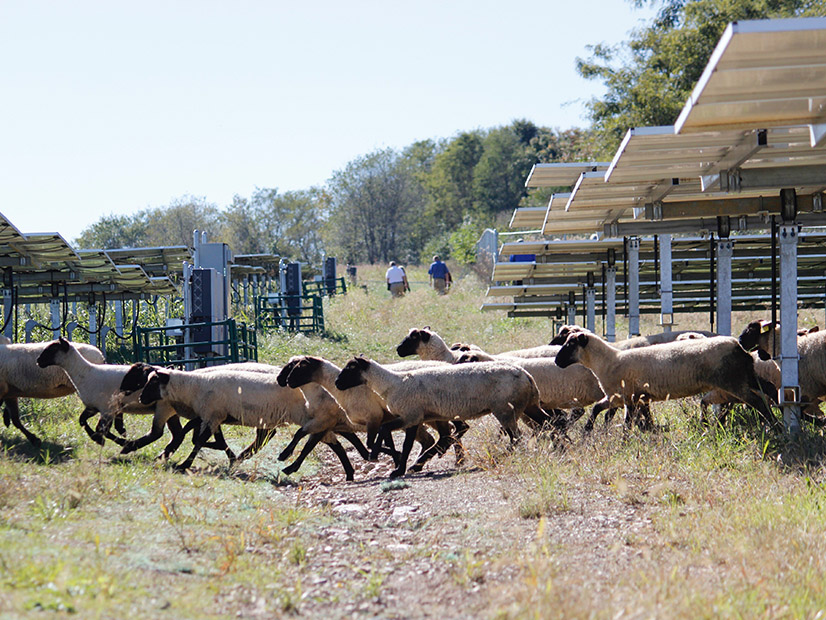
Sheep grazing on solar array lands has been a successful approach in agrivoltaics, but the possibilities are growing for pairing solar with beekeeping, crops and even cattle.
Co-developing agricultural practices and solar has an “incredible amount of potential,” Lexie Hain, executive director of the American Solar Grazing Association (ASGA), said Tuesday at the annual Renewable Energy Vermont conference.
“Sheep and solar are absolutely the most predominant agrivoltaic integration in the U.S. and surely globally,” she said, adding that the practice is “straightforward.” The herd’s vegetation maintenance prevents crops from creating shade on solar panels, and the array infrastructure doesn’t need to be modified to accommodate sheep.
Studies show that the sheep that graze at solar sites don’t have to compete for shade, so they drink less water and have lower stress levels, according to Hain. Their grazing activity also benefits local plant species, with one new study pointing to the biodiversity at grazed arrays being higher than mowed arrays, she said.
In the U.S., there are about 12,000 acres of grazed solar, according to Hain, but she said there are other “big, forward thinking” opportunities for agrivoltaics.
The University of Minnesota studied the effects of grazing cattle in the shade of solar PV systems, Hain said. That study concluded that, while more research is needed, agrivoltaics may reduce the stress from heat on dairy cows and increase their wellbeing.
Solar developer Silicon Ranch, which is a Royal Dutch Shell (NYSE:RDS.A) company, received a U.S. Department of Energy grant this year to study cattle and poultry at the company’s arrays, according to Hain.
In particular, she said, the company is studying the necessary modifications of solar panel racking systems to accommodate cattle.
Another area of “meaningful” agrivoltaics research that Hain sees growing is pairing vegetable crops with solar. The University of Arizona (UA), University of Massachusetts and Oregon State University are all engaged in solar and crops research, she said.
A group of universities that includes UA will work on a project funded by a $10 million, four-year U.S. Department of Agriculture grant announced Oct. 6. The “Sustainably Co-locating Agriculture and Photovoltaic Electricity Systems” project will focus on increasing crop yields, productivity and farmer profits with row, specialty and forage crops.
Putting bee colonies on solar array sites has grown from the level of hobbyists to large-scale beekeepers, according to Hain.
“There are a number of commercial beekeepers in the U.S. and one in Canada who have worked to formalize the process by which beekeeping can be a viable practice to produce a value-added solar honey, and in so doing, gain lands that are accessible 24/7 to them that typically are managed with low or no herbicide use,” she said.
ASGA recently worked with the American Beekeeping Federation to create a solar beekeeping contract.
“We wanted to understand the agricultural viability of this for our solar beekeepers, and we wanted to provide a structure and framework for our solar companies and hosts to understand what the financial expectation and obligation is,” she said.
The contract sets out the basis for which a solar landowner might pay a beekeeper for maintaining an apiary on the solar site. In some cases, co-locating the apiary and solar array would allow the site to qualify as land used in agricultural production under state regulations. The Solar Massachusetts Renewable Target program, for example, offers an additional incentive to solar developers for productive agricultural activity at their projects.
“Most of the states in the Northeast are importers of honey, and this could be another opportunity for value-added production at solar arrays,” Hain said.
Nordic Farm
Vermont entrepreneur Will Raap is using his vision for solar to help Vermont’s ever-shrinking dairy farms. He wants to make his latest project, Nordic Farm, “the most carbon-negative farm in Vermont.”
Part of that vision includes using agrivoltaics to create a profit stream for the dairy farm, which went through bankruptcy four years ago. Raap purchased the farm earlier this year and is planning to build up to 5 MW of ground-mounted solar on marginal, abandoned pastureland and grow berries on the site.
“We’re working with a beverage company, called Shrubbly, to grow aronia, currents and elderberries between the solar panels, which we could harvest for their product,” he said during the conference.
Hinesburg-based Shrubbly produces a sparkling water drink flavored with organic fruit, herbs and spices.
The project team also plans to study the ecosystem benefits of the site, including, for example, carbon sequestration, water retention and pollination.
If Vermont is to realize the emission-reduction targets set by the 2020 Global Warming Solutions Act, Raap estimates the state needs to build between 150 and 300 MW of new solar every year for the next decade. That capacity would require 1,000 to 2,000 acres of land beyond brownfields and the built environment, Raap said.
One solution, he said, could be to repurpose marginal and abandoned farmland that has low or no economic value, especially if the land is on economically stressed dairies.
If Raap can demonstrate how to build multiple income streams with solar and agriculture at Nordic Farm, the project would be a valuable model for other dairies.
“Farmers [can] de-risk their farming situation with diversification in their agriculture, not only to produce more income from renewable energy but to reduce their energy footprint and make them a more carbon-negative farm,” Raap said.

